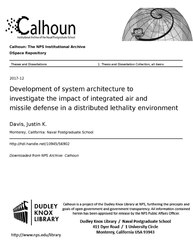File:Development of system architecture to investigate the impact of integrated air and missile defense in a distributed lethality environment (IA developmentofsys1094556902).pdf

Original file (1,275 × 1,650 pixels, file size: 5.86 MB, MIME type: application/pdf, 98 pages)
Captions
Captions
Summary
[edit]| Development of system architecture to investigate the impact of integrated air and missile defense in a distributed lethality environment
( |
||
|---|---|---|
| Author |
Davis, Justin K. |
|
| Title |
Development of system architecture to investigate the impact of integrated air and missile defense in a distributed lethality environment |
|
| Publisher |
Monterey, California: Naval Postgraduate School |
|
| Description |
The proliferation of enemy threat capabilities necessitates increased innovation and a shift in tactical paradigm. The latest strategy pursued by the U.S. Navy is the concept of distributed lethality (DL), an offensive concept that utilizes small groups of ships incorporating deception techniques and distributed weapon systems in order to gain a tactical advantage. This thesis applies a standardized systems engineering approach to investigate the impact of conducting existing integrated air and missile defense (IAMD) operations in the context of this DL concept. An analysis is conducted through the development of an integrated systems architecture and the evaluation of the defined architecture using discrete event simulation. The analysis identifies key performance drivers and operational decisions that balance conflicting requirements for IAMD and DL. The results indicate an average of 11 percent increase in the number of enemy forces killed when conducting a combined mission. This improved lethality required increased vulnerability, resulting in an average increase of half of a hit on defended assets. While the core concepts of DL and IAMD are vastly different, a combined architecture will result in efficient execution of both missions and increased effectiveness of naval forces. Subjects: distributed lethality; Integrated Air and Missile Defense; systems architecture; model based systems engineering; surface warfare |
|
| Language | English | |
| Publication date | December 2017 | |
| Current location |
IA Collections: navalpostgraduateschoollibrary; fedlink |
|
| Accession number |
developmentofsys1094556902 |
|
| Source | ||
| Permission (Reusing this file) |
This publication is a work of the U.S. Government as defined in Title 17, United States Code, Section 101. Copyright protection is not available for this work in the United States. | |
Licensing
[edit]| Public domainPublic domainfalsefalse |
This work is in the public domain in the United States because it is a work prepared by an officer or employee of the United States Government as part of that person’s official duties under the terms of Title 17, Chapter 1, Section 105 of the US Code.
Note: This only applies to original works of the Federal Government and not to the work of any individual U.S. state, territory, commonwealth, county, municipality, or any other subdivision. This template also does not apply to postage stamp designs published by the United States Postal Service since 1978. (See § 313.6(C)(1) of Compendium of U.S. Copyright Office Practices). It also does not apply to certain US coins; see The US Mint Terms of Use.
|
 | |
| This file has been identified as being free of known restrictions under copyright law, including all related and neighboring rights. | ||
https://creativecommons.org/publicdomain/mark/1.0/PDMCreative Commons Public Domain Mark 1.0falsefalse
File history
Click on a date/time to view the file as it appeared at that time.
| Date/Time | Thumbnail | Dimensions | User | Comment | |
|---|---|---|---|---|---|
| current | 10:14, 17 July 2020 |  | 1,275 × 1,650, 98 pages (5.86 MB) | Fæ (talk | contribs) | FEDLINK - United States Federal Collection developmentofsys1094556902 (User talk:Fæ/IA books#Fork8) (batch 1993-2020 #13890) |
You cannot overwrite this file.
File usage on Commons
The following page uses this file:
Metadata
This file contains additional information such as Exif metadata which may have been added by the digital camera, scanner, or software program used to create or digitize it. If the file has been modified from its original state, some details such as the timestamp may not fully reflect those of the original file. The timestamp is only as accurate as the clock in the camera, and it may be completely wrong.
| Short title | Development of system architecture to investigate the impact of integrated air and missile defense in a distributed lethality environment |
|---|---|
| Author | Davis, Justin K. |
| Software used | Davis, Justin K. |
| Conversion program | Microsoft® Word 2016 |
| Encrypted | no |
| Page size |
|
| Version of PDF format | 1.4 |

